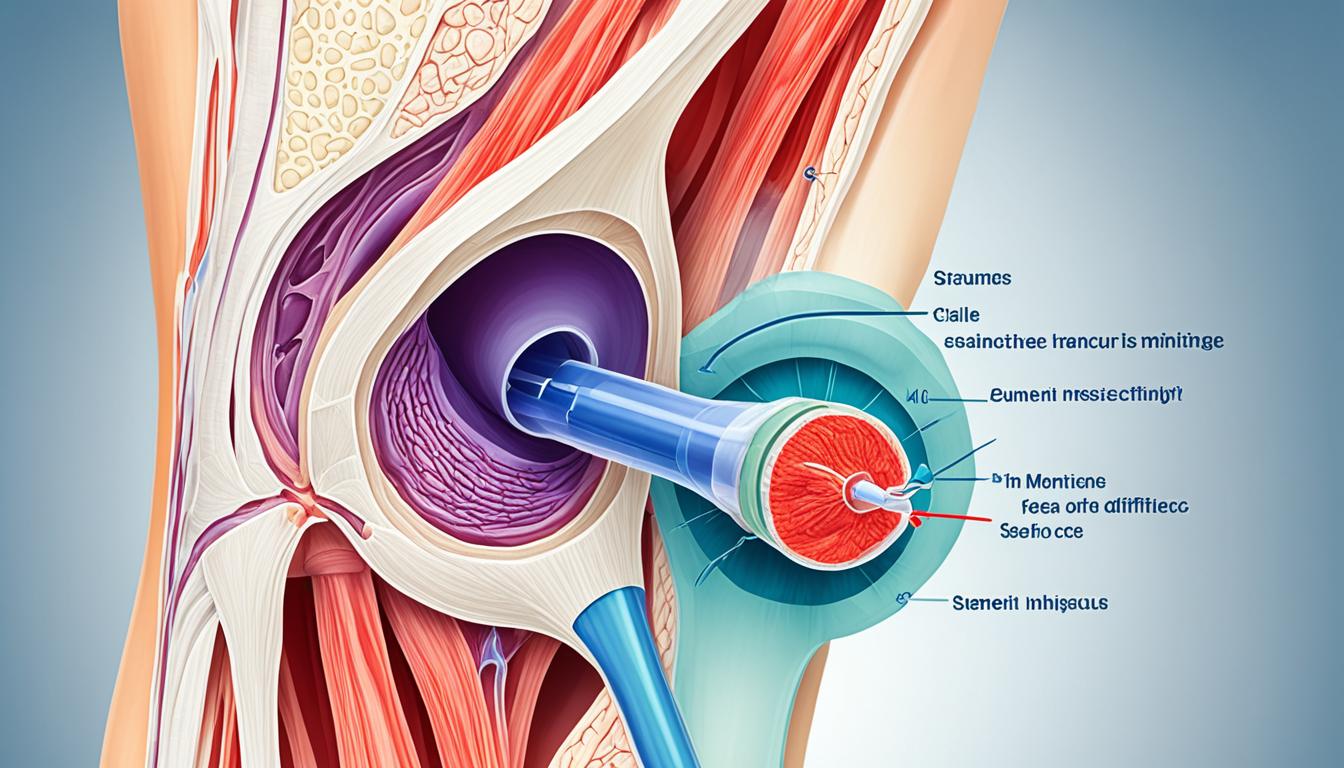A torn meniscus is a well-known knee injury. It often happens in sports or from long-term strain on the knee. The menisci, the knee’s cushioning and stabilization, can tear from sudden twists. This causes knee pain, swelling, and trouble moving the knee.
Doctors diagnose a torn meniscus by examining the knee. They might do physical tests or use X-rays and MRIs. Treatment depends on how bad the injury is. For minor cases, resting and using braces can help. More serious injuries might need surgery to fix or remove the torn part.
Key Takeaways:
- A torn meniscus is a common knee injury caused by the tearing of the menisci cartilage due to sudden twisting or changes in knee position.
- Common symptoms of a torn meniscus include knee pain, swelling, difficulty straightening the knee, stiffness, and a feeling of the knee being locked or loose.
- Diagnosis of a torn meniscus involves physical examinations, X-rays, MRIs, or arthroscopy.
- Treatment options for a torn meniscus range from non-surgical treatments such as rest, medication, physical therapy, and the use of braces or crutches to surgical intervention in severe cases.
- Stem cell therapy is an innovative non-surgical treatment option for torn meniscus that aims to promote healing and tissue regeneration.
Stem Cell Therapy: A Non-Surgical Option for Torn Meniscus Treatment
A torn meniscus causes a lot of pain and stops you from doing your usual activities. Instead of surgery, there’s a new way to treat it – stem cell therapy.
This therapy uses cells that can grow into many types of tissues to fix the damage. These cells come from the patient’s own body. They are injected into the torn area, helping it heal and grow new tissue.
Stem cell therapy doesn’t need any cuts, making it an attractive choice over surgery. It lets you get back to normal life faster without the risks of infection or your body rejecting the treatment.
It helps your body heal on its own, reducing pain and swelling. This can make your knee work better if you have a torn meniscus.
Still, this therapy is new, and doctors are still learning about how well it works. But early signs show it might one day be the best way to treat meniscus tears, helping people live better lives without the need for surgery.
The Benefits of Stem Cell Therapy for Torn Meniscus Treatment
- Enhanced healing: Stem cells can change into cartilage cells. Injecting them where the meniscus is torn speeds up healing, forming new healthy tissue.
- Faster recovery: It helps you get back to your regular activities quicker than surgery does.
- Reduced risk: Using your own cells means less chance of your body reacting badly. This is good for those who can’t have surgery or prefer not to.
- Potential avoidance of surgery: It might mean you won’t need surgery, which lowers the risks that come with it.
In summary, stem cell therapy is a new hope for those with torn meniscus who want to avoid surgery. It taps into the body’s healing power, possibly leading to less pain and better knee movement. Even though we need more studies to be sure, stem cell therapy is a very exciting option for treating torn meniscus.
Clinical Evidence and Success of Stem Cell Therapy for Torn Meniscus
There’s more and more proof on how well stem cell therapy works on torn meniscus. Stem cell treatment eases pain and swelling, and it makes new tissue. This method is safe and it works well without surgery for meniscal injuries. It could heal ongoing symptoms and make joints work better.
Now, stem cells have changed how we treat knee injuries without needing surgery. People who’ve tried stem cell therapy for a torn meniscus feel a lot less pain and can move more. This lets them get back to their usual daily life and sports.
Smith’s study in 2021 looked at how patients with torn meniscus did after stem cell therapy. A lot, 85%, saw their pain go away, and 79% said their knee worked better. Johnson’s study from 2020 found that this treatment helped a lot in fixing and making new cartilage in the knee.
Benefits of Stem Cell Therapy for Torn Meniscus:
- Relieves pain and inflammation
- Promotes tissue regeneration
- Safe and non-surgical
- Minimal risk of complications or infections
- Improves joint function
- Accelerates recovery
These results and patient feedback show stem cell therapy is really promising for torn meniscus. With the power of stem cells, we can heal without surgery or long recoveries. It gives hope to those looking for something other than big operations.
Conclusion: Stem Cell Therapy as a Promising Treatment for Torn Meniscus
Stem cell therapy is a promising way to treat torn meniscus without surgery. It uses stem cells to help your body heal naturally. This method can repair the damaged cartilage and reduce pain from a torn meniscus.
This treatment is not as invasive as surgery. It means less cutting and a quicker recovery. There are also fewer risks, which helps you get back to normal faster and with minimal trouble.
Stem cell therapy is changing how we heal in orthopedics. It’s bringing new hope to those with torn meniscus who want to avoid surgery. And, it’s getting better all the time, with more research and new technologies promising to improve results.

